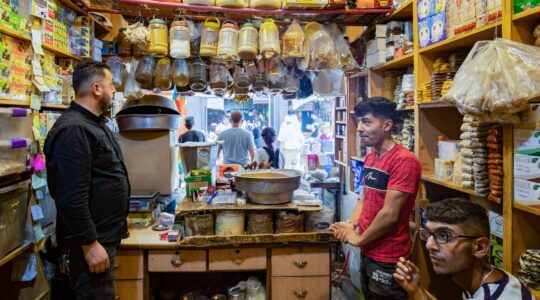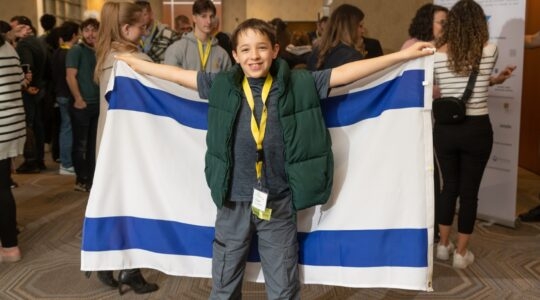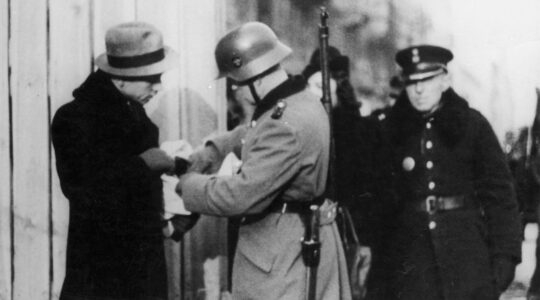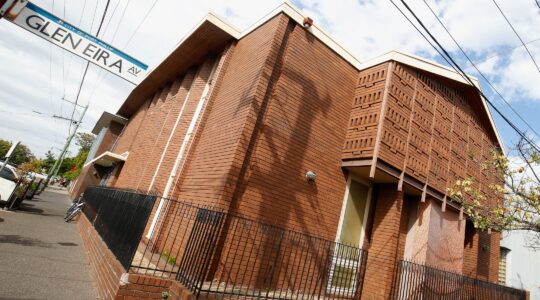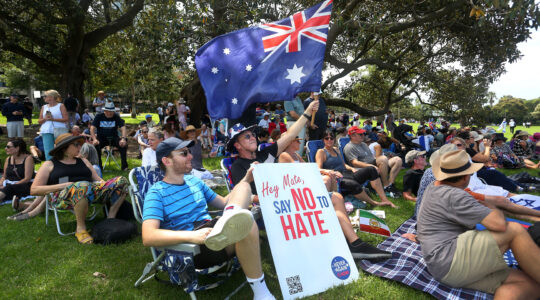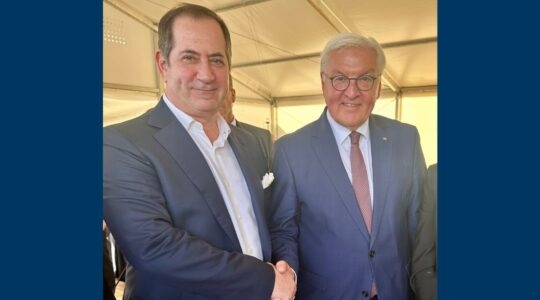
Just before the start of the High Holidays, Jewish Agency Chairman Natan Sharansky nails a mezuzah to the door of the new Israeli Cultural Institute in Budapest. (Ruth Ellen Gruber)
BUDAPEST (JTA) — I always try to spend at least part of the High Holidays in Budapest, so I can sample some of the spicy mixture that characterizes the Jewish experience in the Hungarian capital.
As many as 90,000 Jews live in Budapest, the largest Jewish population in any central European city. The vast majority are unaffiliated — and probably always will be.
Those who do identify as Jews, however tenuously, have an evolving choice of public and private, religious, cultural and secular ways to express or explore their identity.
Gastronomic, too: This year, one friend made challah for the first time to serve at the holiday dinner, and a downtown restaurant even offered a special Rosh Hashanah menu.
Call it “goulash Judaism,” if you will — a simmering mix whose disparate, and often fractious, components combine to form a highly seasoned whole.
Events and observances this year bore witness to the growing array of Jewish options, both inside and outside traditional settings.
The week leading up to Rosh Hashanah, for example, saw the conclusion of the city’s 13th annual Jewish Summer Festival, a 10-day series of performances and other events, including a book and crafts fair, that drew thousands of visitors. Also that week, an ambitious Israeli Cultural Institute opened in a refurbished building at the edge of the main old downtown Jewish quarter.
And further afield, in the Obuda district in the northern part of the city, a 190-year-old synagogue that had been used for decades as a state TV studio was rededicated as a Jewish house of worship.
Rented from the state and restored by Chabad, the synagogue will form part of Chabad’s growing local network.
Foreign VIPs were in town for all three occasions.
The Jewish Summer Festival culminated with a well-publicized concert by the Chasidic reggae rapper Matisyahu in a major city event arena.
Jewish Agency Chairman Natan Sharansky affixed the mezuzah to the doorpost of the Israeli Cultural Institute, which was largely funded by the agency. Institute director Gabor Balazs said the institute’s aim was to introduce and popularize Israel’s “mosaic-like” culture to the Jewish and non-Jewish public at large.
And Israel’s Ashkenazi chief rabbi, Yonah Metzger, joined Chabad rabbis in cutting the ribbon at the Obuda synagogue.
“This is the best possible answer to what the Nazis did,” Metzger told the crowd of 1,000 or more, including Hungarian government and religious leaders, attending the ceremony. “Fifty years after the last time Rosh Hashanah was celebrated here, it will be celebrated here once again.”
My own holiday observances also reflected new choices.
I usually attend High Holidays services at one of the 15 or so mainstream synagogues active in Budapest, or sometimes I “synagogue hop” to two or three shuls. Most of them belong to the Neolog movement — the Hungarian variant of Reform Judaism that is the country’s dominant religious stream. But there are also several traditional Orthodox synagogues, as well three or four now affiliated with Chabad.
This year I chose to avoid the mainstream. I sampled Rosh Hashanah services at two small alternative groups — Bet Orim, one of Budapest’s two American-style Reform congregations, and Dor Chadash, a young people’s minyan associated with the Masorti, or Conservative, movement.
As neither Reform nor Masorti is recognized by the Hungarian Jewish Federation, both operate outside the umbrella of establishment Jewry.
Bet Orim celebrated a formal service in the auditorium of the Budapest JCC, while Dor Chadash held a more informal gathering in the living room of the local Moishe House, a downtown apartment that serves as a combination residence and center for Jewish educational encounters.
Each group numbered about 30 or 35 people, and both offered an American-style egalitarian Jewish prayer experience that is alien to mainstream Hungarian Jewry.
At Bet Orim, in fact, a young woman named Flora Polnauer served as the cantor for High Holidays services.
“It’s the first time that a Hungarian Jewish woman has fulfilled this role,” Bet Orim’s rabbi, Ferenc Raj, told me proudly.
Raj, a native of Hungary, moved to the United States decades ago and is rabbi emeritus of Congregation Beth El in Berkeley, Calif.
“We are making history tonight,” he said.
I had met Polnauer before under quite different circumstances. The daughter of a rabbi, she sings with several local music groups, including hard-driving Jewish hip hop bands.
During the service, dressed in white, she chanted the familiar melodies in a lilting voice. But she looked a little nervous and was clearly moved by the experience.
“I really feel we deserve the Shehecheyanu!” she exclaimed at the end, referring to the blessing recited to mark special occasions and moments of joy.
We all joined in and chanted it with her: “Blessed are you, O Lord, our God, sovereign of the universe who has kept us alive, sustained us, and enabled us to reach this season.”
(Ruth Ellen Gruber’s books include “National Geographic Jewish Heritage Travel: A Guide to Eastern Europe,” “Letters from Europe (and Elsewhere),” and “Virtually Jewish: Reinventing Jewish Culture in Europe.” She blogs on Jewish heritage issues at http://jewish-heritage-travel.blogspot.com.)
JTA has documented Jewish history in real-time for over a century. Keep our journalism strong by joining us in supporting independent, award-winning reporting.
